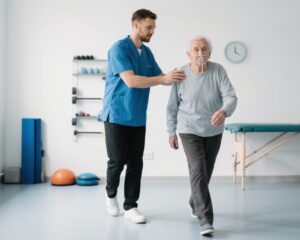Study Background and Disease Burden
Knee osteoarthritis (KOA) is a prevalent degenerative joint disease among older adults, particularly affecting women and significantly impairing physical function and quality of life. The progressive decline in muscle strength and joint function contributes to disability and increased healthcare burden. Interventions that alleviate symptoms and preserve mobility are critical for healthy aging.
Oestrogen replacement therapy (ERT) has been proposed to have beneficial effects on musculoskeletal health due to estrogen’s role in maintaining bone density and muscle function. However, its combined effect with resistance exercise, a cornerstone intervention improving muscle strength and physical performance, remains inadequately explored in the older female KOA population.
Study Design
This was a double-blind, placebo-controlled, randomised clinical trial designed to evaluate whether low-dose ERT combined with a muscle resistance exercise programme (MREP) confers additional benefits over exercise alone in older women with KOA.
The study enrolled 75 community-dwelling women aged 65 years or older, all diagnosed with chronic knee pain and clinically confirmed KOA. Participants underwent a 3-month structured resistance exercise programme targeting lower limb muscles and were randomly assigned to receive either daily low-dose transdermal ERT (oestradiol 0.54 mg/day) or a placebo patch.
Outcome assessments were conducted at baseline, immediately post-intervention, and at 12-month follow-up. The primary endpoint was change in physical function assessed by the 30-second chair stand test (CS-30), a validated measure of lower extremity strength and endurance. Secondary outcomes included muscle mass, knee extension strength, walking speed, metabolic parameters, knee pain (using a standardized pain scale), and health-related quality of life measured by the 12-item Short-Form Health Survey (SF-12).
Statistical analyses applied intention-to-treat principles, using linear regression models to compare between-group differences in changes from baseline.
Key Findings
Out of 168 screened individuals, 75 participants (mean age 73.8 ± 5.8 years) were randomised (ERT group: 37; placebo group: 38). Baseline CS-30 scores were similar between groups (ERT: 14.81 ± 3.95; placebo: 15.58 ± 3.48 repetitions).
After 3 months, both groups showed improvements in CS-30 scores. The ERT group improved by an average of 2.59 repetitions (SD 2.58), whereas the placebo group improved by 1.79 repetitions (SD 2.28). The primary analysis revealed no statistically significant difference in CS-30 change between groups [regression coefficient 0.81, 95% confidence interval (CI) -0.31 to 1.92; P = 0.16].
Secondary analyses indicated no significant differences in muscle mass, knee extension strength, walking performance, metabolic indicators, or knee pain scores between groups overall.
However, post hoc subgroup analyses suggested that participants with early-stage KOA might derive more pronounced functional improvements from combined ERT and exercise. In addition, the ERT group experienced a significant improvement in mental health domain scores on the SF-12 compared to placebo, indicating potential psychological benefits.
Importantly, no serious adverse events were reported, supporting the safety of low-dose transdermal ERT in this setting.
Expert Commentary
While resistance exercise remains a foundational treatment for KOA, the role of adjunctive pharmacologic treatments such as ERT is less clear. This trial’s lack of statistically significant additive effect overall might reflect the dose, duration, or the heterogeneous nature of KOA progression.
The observed mental health improvement aligns with known central effects of estrogen on mood and cognition, warranting further mechanistic studies.
Limitations include the modest sample size and exploratory nature of subgroup analyses, which should be interpreted cautiously. Longer-term studies with stratified patient selection based on KOA stage may better elucidate the subgroup-specific benefits.
Current guidelines do not routinely recommend ERT for KOA but acknowledge its potential musculoskeletal effects; future evidence might support a more targeted therapeutic approach.
Conclusion
This randomised controlled trial demonstrates that low-dose transdermal estrogen replacement therapy combined with resistance exercise does not significantly enhance physical function improvements in older women with KOA compared to exercise alone. Nevertheless, potential benefits in early-stage KOA and mental health suggest that ERT could be considered as an adjunct in selected patients.
These findings contribute to optimizing multimodal interventions aimed at preserving mobility and quality of life in ageing women and underscore the need for further targeted research.
References
Mitoma T, Ooba H, Takahashi K, Kondo T, Ikeda T, Sakamoto Y, Mitsuhashi T, Maki J. Oestrogen replacement combined with resistance exercise in older women with knee osteoarthritis: a randomised, double-blind, placebo-controlled clinical trial. Age Ageing. 2025 Aug 1;54(8):afaf224. doi: 10.1093/ageing/afaf224. PMID: 40794913; PMCID: PMC12342371.



